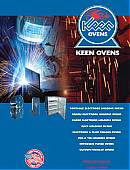Industrial Ovens
Front-Loading
![]() Under 10 cubic feet
Under 10 cubic feet
![]() 10-20 cubic feet
10-20 cubic feet
![]() Over 20 cubic feet
Over 20 cubic feet
![]() See All
See All
Top-Loading
![]() Under 10 cubic feet
Under 10 cubic feet
![]() 10-20 cubic feet
10-20 cubic feet
![]() Over 20 cubic feet
Over 20 cubic feet
![]() See All
See All
Learn About Our Industrial Ovens
Welding Ovens
![]() Stick Electrodes
Stick Electrodes
![]() Sub-Arc Flux
Sub-Arc Flux
![]() Wire Spools
Wire Spools
![]() Tig Filler Wire
Tig Filler Wire
![]() Multi-Purpose
Multi-Purpose
![]() Nitrogen Purge
Nitrogen Purge
![]() See All
See All
 Order Our Free Catalog Today Click Here |
| Available Inventory |
How Flux-Cored Arc Welding WorksFlux-Cored Arc Welding is a welding method that is somewhat unique compared to Metal Inert Gas welding. What primarily distinguishes FCAW from MIG welding is the type of wire electrode that is used and the way the molten metal is protected from the atmosphere. The MIG welding process uses a continuous solid wire electrode, typically made of mild steel. An external gas supply is required to create a shield for protecting the molten pool. This is usually provided by a high-pressure gas cylinder. As with MIG, FCAW requires electricity, filler metal, and some way to shield the molten metal from the air. In contrast to the MIG process, the flux-cored method uses a wire that contains an inner core made of materials that produce fluxing agents and shielding gases when burned by the heat of the welding arc. This type of wire eliminates the need for an external gas supply, because it has internal shielding properties. Using the FCAW MethodFlux-Cored Arc Welding works better than MIG welding when working with thicker materials. In fact, FCAW is recommended only on materials that are no thinner than 20 gauge. When using the FCAW process on thicker metals, a good, strong weld can be produced in a single pass. Because the flux-cored wire produces its own shielding gas during the welding process, FCAW works much better outdoors than does the MIG method. This internal shielding can even endure strong breezes. There is no need to carry a separate gas cylinder to the welding site, which makes FCAW more convenient. One of the downsides of using FCAW is that the welding arc does make spatter. As a result, the finished weld gets covered with a slag which may have to be removed. To begin the welding process using the flux-cored method, the welder first squeezes the trigger, which begins feeding the electrode continuously to the joint. As the electrode is fed through the wire feeder, it becomes electrically charged. When the wire reaches the metal joint, a short circuit occurs, which causes the electrode to heat up and begin to melt. As the wire electrode melts, the metal begins to melt, too. Together, the melting electrode and metal form a molten pool. The pool simultaneously melts the flux core of the electrode to create a protective shield from the environment and a slag that protects the weld from contamination. Which Metals Work Best With FCAWMost non-ferrous exotic metals, including aluminum, cannot be welded using the flux-cored method. However, flux-cored welding works well on most carbon steels, nickel-based alloys, cast iron, and some stainless steels. References: Related Articles: Flux-Cored Wire versus Solid Wire Flux-Cored Arc Welding Techniques
|